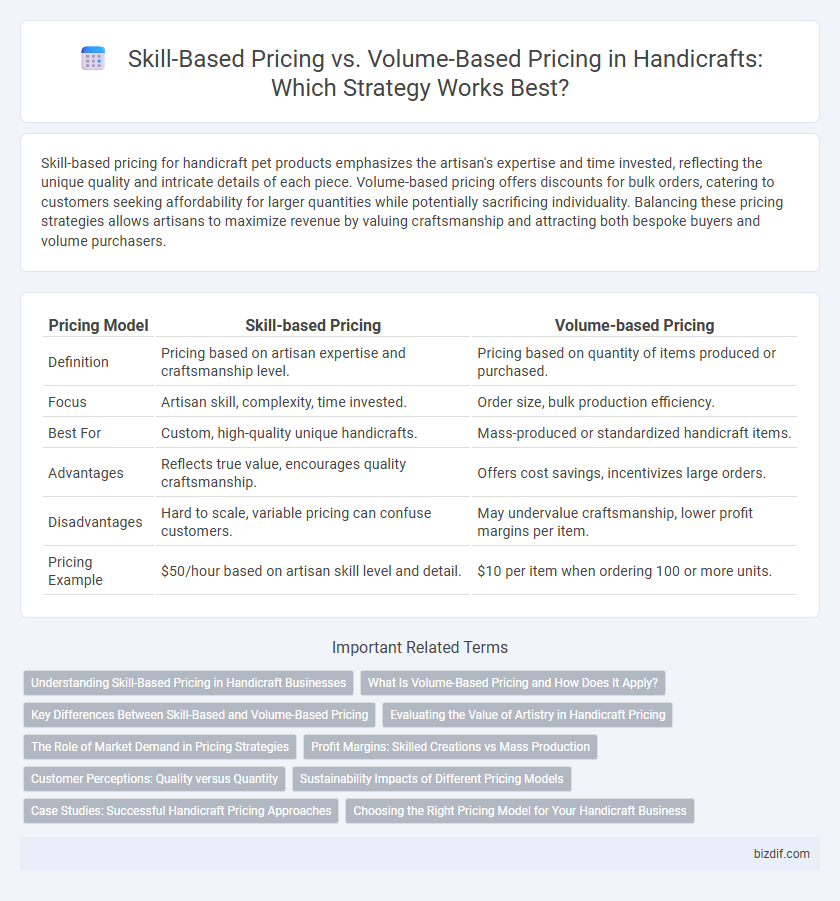Skill-based pricing for handicraft pet products emphasizes the artisan's expertise and time invested, reflecting the unique quality and intricate details of each piece. Volume-based pricing offers discounts for bulk orders, catering to customers seeking affordability for larger quantities while potentially sacrificing individuality. Balancing these pricing strategies allows artisans to maximize revenue by valuing craftsmanship and attracting both bespoke buyers and volume purchasers.
Table of Comparison
| Pricing Model | Skill-based Pricing | Volume-based Pricing |
|---|---|---|
| Definition | Pricing based on artisan expertise and craftsmanship level. | Pricing based on quantity of items produced or purchased. |
| Focus | Artisan skill, complexity, time invested. | Order size, bulk production efficiency. |
| Best For | Custom, high-quality unique handicrafts. | Mass-produced or standardized handicraft items. |
| Advantages | Reflects true value, encourages quality craftsmanship. | Offers cost savings, incentivizes large orders. |
| Disadvantages | Hard to scale, variable pricing can confuse customers. | May undervalue craftsmanship, lower profit margins per item. |
| Pricing Example | $50/hour based on artisan skill level and detail. | $10 per item when ordering 100 or more units. |
Understanding Skill-Based Pricing in Handicraft Businesses
Skill-based pricing in handicraft businesses reflects the unique expertise and time invested in creating each piece, ensuring that artisans are fairly compensated for their specialized skills and craftsmanship. This pricing strategy highlights the value of intricate techniques and quality materials, distinguishing handcrafted items from mass-produced goods. Understanding skill-based pricing enables independent artists to maintain sustainable livelihoods by aligning price with the complexity and artistic merit of their work.
What Is Volume-Based Pricing and How Does It Apply?
Volume-based pricing in handicraft refers to setting prices according to the quantity of items purchased, encouraging customers to buy larger quantities of handmade goods. This pricing strategy benefits artisans by increasing sales volume while offering discounts or reduced rates per unit, making it attractive for bulk buyers and wholesale partners. Applying volume-based pricing allows craftsmen to optimize production efficiency and balance cost per item without compromising handcrafted quality.
Key Differences Between Skill-Based and Volume-Based Pricing
Skill-based pricing in handicraft centers on the artisan's expertise, craftsmanship quality, and intricate techniques, often leading to higher prices for unique, bespoke items. Volume-based pricing reduces cost per unit by producing larger quantities, appealing to customers seeking affordability over exclusivity. The key difference lies in valuing individual skill and time investment versus cost efficiency and scale of production.
Evaluating the Value of Artistry in Handicraft Pricing
Skill-based pricing in handicraft emphasizes the unique expertise, time, and intricate techniques involved in creating each piece, reflecting the true artistic value and craftsmanship. Volume-based pricing, driven by production quantities, often undermines the individual artistry by standardizing costs, which may not account for the labor-intensive processes and creative skill. Assessing handicraft pricing through the lens of skill ensures fair compensation for artisans and highlights the cultural and aesthetic worth embedded in each handcrafted item.
The Role of Market Demand in Pricing Strategies
Market demand plays a crucial role in determining whether skill-based pricing or volume-based pricing is more effective for handicraft businesses. High demand for unique, handcrafted items often supports skill-based pricing, reflecting the artisan's expertise and time invested. Conversely, when demand prioritizes affordability and quantity, volume-based pricing can attract larger customer segments by offering discounts for bulk purchases.
Profit Margins: Skilled Creations vs Mass Production
Skill-based pricing for handicrafts leverages the artisan's expertise, allowing higher profit margins due to the unique, high-quality nature of each piece. In contrast, volume-based pricing suits mass production by reducing costs per unit but often results in lower profit margins because of increased competition and standardized products. Balancing these pricing strategies enables artisans to optimize profitability while maintaining craftsmanship value.
Customer Perceptions: Quality versus Quantity
Skill-based pricing emphasizes craftsmanship and unique artistry, leading customers to perceive higher quality and exclusivity in handicrafts. Volume-based pricing attracts buyers seeking affordability and larger quantities, but may raise concerns about diminished uniqueness and mass production. Customer perception often prioritizes skill and detail in handicrafts, associating higher prices with superior value and authenticity.
Sustainability Impacts of Different Pricing Models
Skill-based pricing in handicrafts promotes sustainable livelihoods by fairly compensating artisans for their expertise, encouraging the preservation of traditional techniques and reducing overproduction. Volume-based pricing often leads to mass production, increasing resource consumption and waste, which can undermine ecological sustainability. Prioritizing skill-based models supports ethical sourcing and long-term environmental stewardship in the handicraft industry.
Case Studies: Successful Handicraft Pricing Approaches
Case studies in the handicraft sector reveal that skill-based pricing often yields higher profitability by accurately reflecting the artisans' expertise and time invested, as seen with premium handcrafted jewelry brands. Volume-based pricing suits mass-produced handicrafts such as woven baskets or ceramics, enabling competitive pricing and broader market reach. Combining both strategies allows businesses like fair-trade cooperatives to maximize revenue by targeting niche markets with skill-intensive products while leveraging volume discounts for simpler items.
Choosing the Right Pricing Model for Your Handicraft Business
Skill-based pricing reflects the unique craftsmanship and time invested in each handmade product, ensuring fair compensation for artisans' expertise. Volume-based pricing offers competitive rates for bulk orders, appealing to retailers or customers seeking larger quantities. Selecting the right pricing model depends on your target market, production capacity, and the distinct value of your handcrafted items.
Skill-based pricing vs Volume-based pricing Infographic

 bizdif.com
bizdif.com